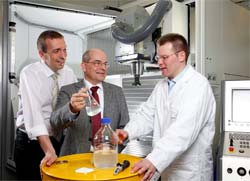Improved lubrication without oil

Dr. Peter Eisner, Dr. Michael Menner and Andreas Malberg. Developed a cooling lubricant from aqueous biopolymers. Astonishing the lubricant industry by finding: “Water lubricates like oil”. © Dirk Mahler / Fraunhofer<br>
Metalworking plays a key role in industry. Drilling, milling, turning and grinding operations all use lubricants to prevent work pieces and tools from overheating and from excess wear. Standard lubricants today are based on mineral oil.
This has drawbacks: fossil mineral oils come from finite resources, transport relatively little heat away from the work piece, are harmful to health and are flammable. All of this calls for extreme technical efforts, for occupational safety, fire safety and disposal, for example. So there‘s a need for alternative lubricants.
Renewable raw materials as a lubricant additive
The idea hatched by Andreas Malberg, Dr. Peter Eisner and Dr. Michael Menner from the Fraunhofer Institute for Process Engineering and Packaging IVV in Freising sounds simple as well as surprising: lubricate with water, not oil. “At IVV here in Freising, we have been looking at the issue of cooling lubricants for some considerable time”, explains Michael Menner. “In two projects supported by the Federal Ministry of Education and Research, we have successfully replaced oil with water. One surprising thing we found was that water is no worse a lubricant than oil, the key to it all being the additives.” Adding natural polymers to water can dramatically improve its lubricating properties. The Freising-based researchers set about testing renewable raw materials such as celluloses, starches or bacterial polysaccharides and improving their use as lubricant additives. Their aim: to make water more viscous by adding biopolymers, so it lubricates better.
For the idea to become a marketable product, other partners were brought on board: the Institute for Machine Tool Engineering and Production Technology at the University of Braunschweig, and Carl Bechem GmbH – a lubricant manufacturer from Hagen, Germany. The basic fluid made by the IVV, the viscous water, was improved by adding water-soluble additives so it could be used as an anti-corrosion agent, for example. That‘s how it meets the requirements during processing: withstanding high temperatures and shearing stresses.
Benefits: Easy on the environment and on gentle to the skin, does not burn
In addition to the significantly lower impact on the environment and the high raw material efficiency, the new lubricant also offers technological benefits. It reduces wear and prolongs tool life, for example. The processed components are also easier to clean. This cuts costs and improves the cost-efficiency of the entire production process. Converting to the new lubricant is very easy for companies to carry out”, explains Peter Eisner. “In principle, once thoroughly cleaned, the same machine tool circulation systems can be used.” In addition, the use of the aqueous lubricant improves occupational health and safety and hygiene: no formation of oil mists, addition of fewer biocides, it smells better and is gentler on the skin.
For the mineral oil-free lubricant made of aqueous biopolymer solutions for use in metalworking applications, Dr. Peter Eisner, Dipl.-Ing. Andreas Malberg and Dr. Michael Menner will receive one of the 2012 Joseph-von-Fraunhofer awards. The newly developed lubricant is already being distributed by Carl Bechem GmbH under the product name of BERUFLUID and is in use in various metalworking companies in the manufacturing of tools, mechanical engineering, in the automotive and aviation industry and in medical technology.
Media Contact
All latest news from the category: Process Engineering
This special field revolves around processes for modifying material properties (milling, cooling), composition (filtration, distillation) and type (oxidation, hydration).
Valuable information is available on a broad range of technologies including material separation, laser processes, measuring techniques and robot engineering in addition to testing methods and coating and materials analysis processes.
Newest articles

An Endless Loop: How Some Bacteria Evolve Along With the Seasons
The longest natural metagenome time series ever collected, with microbes, reveals a startling evolutionary pattern on repeat. A Microbial “Groundhog Year” in Lake Mendota Like Bill Murray in the movie…

Witness Groundbreaking Research on Achilles Tendon Recovery
Achilles tendon injuries are common but challenging to monitor during recovery due to the limitations of current imaging techniques. Researchers, led by Associate Professor Zeng Nan from the International Graduate…

Why Prevention Is Better Than Cure—A Novel Approach to Infectious Disease Outbreaks
Researchers have come up with a new way to identify more infectious variants of viruses or bacteria that start spreading in humans – including those causing flu, COVID, whooping cough…



